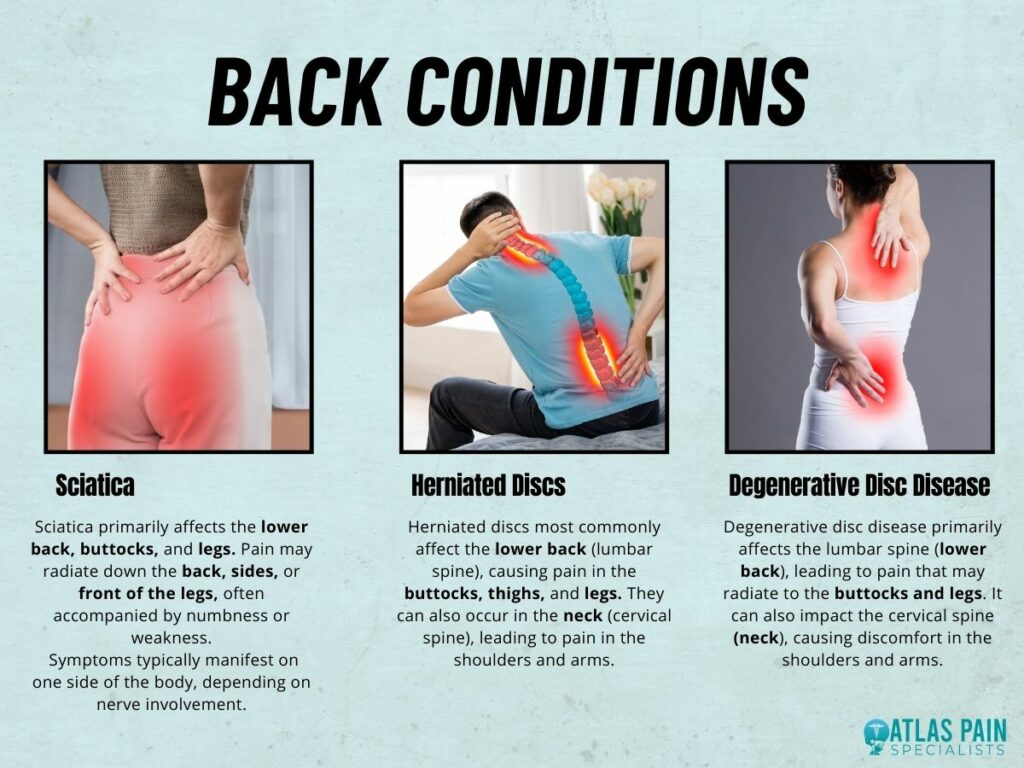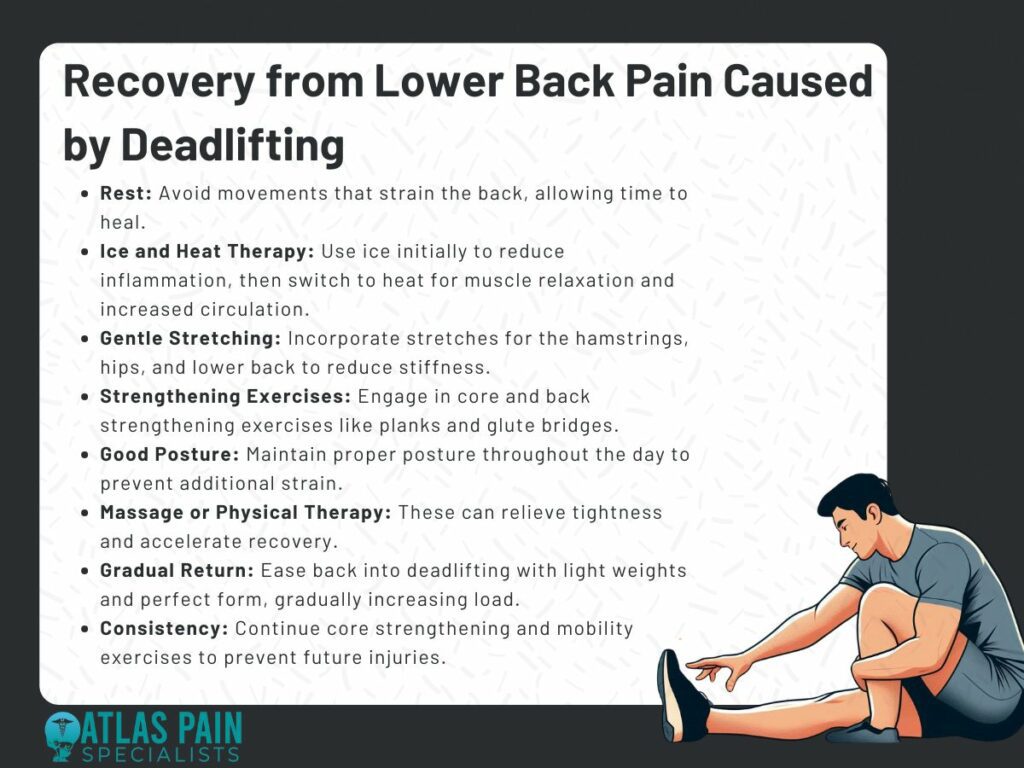

Understand Lower Back Pain from Deadlifting
Deadlifting is a powerful exercise that builds strength and enhances athletic performance, but it can also lead to lower back pain if not performed correctly. This article explores the common causes of lower back pain from deadlifting, such as poor technique, weak supporting muscles, and overtraining. It highlights the importance of maintaining proper form and strengthening key muscle groups to prevent injury.
Additionally, the article provides practical recovery strategies to manage pain and guide a safe return to lifting. It also explains when it’s essential to seek medical attention for persistent or severe back issues, ensuring a comprehensive approach to avoiding and recovering from lower back pain related to deadlifting.
Causes of Lower Back Pain from Deadlifting
Lower back pain from deadlifting can be caused by several factors, often related to improper form, technique, or inadequate conditioning. Here are some of the primary causes:
1. Poor Lifting Form
Rounding your lower back during a deadlift puts excessive stress on your spine, especially the lumbar region. This can lead to muscle strains, disc injuries, or even herniation over time.
2. Weak Core Muscles
A weak core means your abdominal muscles aren't able to stabilize your spine properly during the lift. This forces your lower back to overcompensate, placing extra strain on the muscles and ligaments.
3. Insufficient Mobility
Limited flexibility in the hamstrings, hips, or upper back restricts your range of motion. This forces your lower back to do more work, increasing the risk of muscle fatigue, pain, or injury.
4. Overtraining or Lifting Too Heavy
Lifting too much weight too soon or not allowing enough recovery between sessions can overload your lower back muscles. This strain can lead to injuries like muscle pulls or disc issues.
5. Inadequate Warm-Up
Not warming up properly before deadlifting leaves your muscles stiff and unprepared for heavy lifting. This increases the risk of straining or overloading your lower back muscles during the exercise.
6. Muscle Imbalances
When your glutes and hamstrings are weak or underdeveloped, your lower back has to take on more of the lifting load. This imbalance causes extra stress on the lumbar region, which can lead to pain or injury.
7. Pre-existing Conditions
If you have pre-existing back conditions like herniated discs, sciatica, or degenerative disc disease, deadlifting can aggravate these issues. These conditions often cause chronic pain, which can worsen with improper lifting.

8. Poor Recovery or Insufficient Rest
Lack of proper rest between deadlifting sessions doesn’t give your muscles time to recover and repair. This can lead to fatigue, compromised form, and increased stress on the lower back, raising the risk of injury.
To avoid lower back pain, focus on using good form, strengthening your core, stretching regularly, and not pushing your body too hard too soon. Proper recovery and rest are just as important as the lifts themselves.
Prevention of Lower Back Pain from Deadlifting
Preventing lower back pain from deadlifting mostly comes down to a combination of good technique, proper preparation, and smart training habits. Here are some key ways to avoid injury and keep your lower back healthy:

1. Master Proper Form
Keep a neutral spine and avoid rounding your lower back during the lift to reduce strain on your spine. Engage your core and ensure the bar stays close to your body throughout the movement.
2. Strengthen Your Core
A strong core helps stabilize your spine and prevents overloading the lower back. Incorporate exercises like planks and leg raises to build abdominal strength and support your lifting form.
3. Build Up Your Posterior Chain
Focus on strengthening your glutes, hamstrings, and lower back to take pressure off your spine. Exercises like Romanian deadlifts and glute bridges can help develop these muscles.
4. Work on Flexibility and Mobility
Improving flexibility in your hamstrings, hips, and upper back allows for better movement and reduces stress on your lower back. Regular stretching and foam rolling can improve mobility and prevent injury.
5. Warm Up Properly
Always start with a dynamic warm-up to increase blood flow and prepare your muscles for the lift. Incorporate leg swings, bodyweight squats, and light cardio to loosen up your muscles before lifting.
6. Start Light and Progress Gradually
Begin with lighter weights to perfect your technique before increasing the load. Gradually add weight as your strength improves, ensuring your form stays, solid and your muscles adapt.
7. Listen to Your Body
Pay attention to any discomfort or pain during and after deadlifts, and adjust your form or the weight you're lifting. Don’t push through pain, as it can lead to more serious injuries.
8. Get Adequate Rest and Recovery
Allow your muscles to recover fully between lifting sessions to avoid fatigue and muscle strain. Prioritize sleep, rest days, and proper nutrition to support muscle repair and growth.
By focusing on form, building strength where it counts, and being mindful of your body's limits, you can avoid lower back pain and deadlift safely for the long term.
Recovery from Lower Back Pain Caused by Deadlifting
Recovering from lower back pain caused by deadlifting requires a combination of rest, rehabilitation exercises, and a gradual return to lifting. Here's a step-by-step approach to help you recover and prevent future issues:
1. Rest and Avoid Aggravating Movements
Give your lower back time to heal by avoiding heavy lifting or exercises that strain the area. Gentle movement, like walking, can help maintain circulation without worsening the pain.
2. Ice and Heat Therapy
Apply ice in the first 48 hours to reduce inflammation, then switch to heat to relax muscles and increase blood flow. Both can help alleviate pain and promote healing.
3. Gentle Stretching and Mobility Work
Once the pain subsides, incorporate gentle stretches to improve flexibility and reduce muscle tightness. Focus on stretches for the hamstrings, hips, and lower back to avoid stiffness.
4. Strengthening Exercises for Core and Back
Start strengthening your core and back muscles with low-impact exercises like bird dogs, planks, and glute bridges. These exercises support the spine and help prevent future injuries.
5. Use Proper Posture and Ergonomics
Maintain good posture throughout the day to avoid putting additional strain on your lower back. Proper sitting and standing habits help support recovery and reduce pain.
6. Massage or Physical Therapy
Massage can relieve muscle tightness, while physical therapy can provide specific exercises for strengthening and mobility. Both help accelerate recovery and reduce the risk of re-injury.
7. Gradual Return to Deadlifting
Ease back into deadlifting with lighter weights and perfect form, focusing on maintaining a neutral spine. Gradually increase the load as your back strengthens and the pain resolves.
8. Stay Consistent with Core and Mobility Work
Continue to strengthen your core and improve flexibility even after recovering to prevent future injuries. Regular core and mobility exercises will keep your back strong and flexible for lifting.
By giving yourself time to heal, strengthening the right muscles, and returning to deadlifting gradually, you’ll be able to recover effectively and reduce the risk of future lower back pain.
When to Seek Medical Attention
While most cases of lower back pain from deadlifting can be managed with rest and rehab, there are times when you should seek medical attention. Here are the key signs that it's time to consult a doctor or specialist:
1. Severe or Persistent Pain
If the pain is sharp, intense, or doesn’t improve after a few days of rest and treatment, it may be a sign of a serious injury. Ongoing or worsening pain requires professional evaluation.
2. Radiating Pain (Sciatica)
Pain that travels down your leg, accompanied by tingling, numbness, or weakness, may indicate nerve involvement, like a herniated disc. This requires medical attention to avoid long-term damage.
3. Loss of Function
If you’re struggling to stand, walk, or perform basic movements due to pain, it’s a sign that your injury may be more severe. Loss of function often means you need immediate medical help.
4. Weakness in the Legs or Feet
If you experience leg weakness or difficulty controlling foot movements, it could indicate nerve compression. This is a concerning sign and should be evaluated by a healthcare professional.
5. Bladder or Bowel Dysfunction
Incontinence or loss of control over bladder or bowel function is a medical emergency. These symptoms may indicate cauda equina syndrome, which requires immediate intervention.
6. Increased Pain with Coughing, Sneezing, or Bending
Pain that intensifies when coughing, sneezing, or bending forward can indicate disc problems or nerve irritation. Seek medical advice if this pain persists or worsens.
7. Pain After a Fall or Trauma
If the pain started after a fall, accident, or heavy lift, it may indicate a fracture or more serious injury. You should consult a doctor to rule out structural damage.
8. Pain with Fever or Unexplained Weight Loss
Pain accompanied by fever, unexplained weight loss, or night pain suggests an infection or other serious condition. This requires urgent medical evaluation.
9. No Improvement After Several Weeks
If your lower back pain doesn’t improve after 4-6 weeks of consistent care (rest, stretching, strengthening exercises), it's worth seeking professional evaluation. This could indicate an underlying issue that needs more specific treatment.
In these situations, it’s always better to err on the side of caution and get checked by a healthcare professional. They can provide a proper diagnosis and recommend a treatment plan tailored to your condition.
Conclusion
This article covers the causes, prevention, and recovery of lower back pain from deadlifting. It identifies common causes such as poor form, weak supporting muscles, overtraining, and mobility issues. To prevent injury, it emphasizes the importance of proper technique, strengthening key muscle groups, and gradually increasing weight.
For recovery, the article suggests rest, stretching, mobility exercises, and core strengthening. It also highlights when to seek medical attention for severe or persistent pain, ensuring a balanced approach to avoiding and addressing back issues related to deadlifting.
About Dr. Sean Ormond



